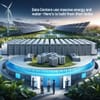Data centers are notorious for their massive energy and water consumption, but there are strategies to build them more sustainably. Improving cooling efficiency is crucial, and this can be achieved by optimizing evaporation rates in cooling towers and maintaining the water system to minimize water consumption. Implementing advanced power management features can also intelligently adjust server power consumption based on workload.
Free cooling is another effective strategy, leveraging outside air or water for cooling when ambient temperatures are low. This can be achieved through air economizers or water-side economizers, significantly reducing energy consumption. Liquid cooling, such as direct-to-chip cooling and immersion cooling, can reduce energy consumption by up to 95% and water use by up to 91%. These methods are particularly effective for high-performance computing applications like AI and machine learning.
Incorporating renewable energy sources, such as solar panels or wind power, can also generate clean energy on-site. Building data centers near abundant renewable energy resources can minimize transmission losses. Closed-loop cooling systems, water recycling and reuse, and water monitoring and management are also essential for reducing water consumption.
Strategic site selection is critical, and data centers should be built in locations with ample water resources, cooler climates, or access to renewable energy. Modular and edge architectures can also leverage local cooling resources and reduce transmission losses. By adopting these strategies, data centers can significantly reduce their environmental impact while maintaining their critical role in supporting the digital economy.


